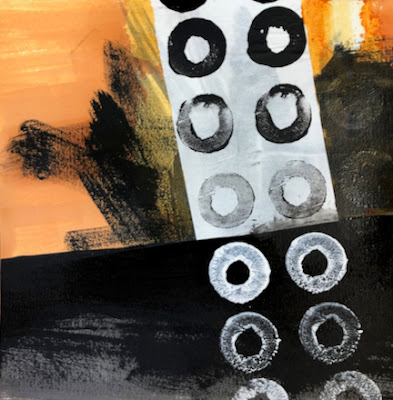I have found this downloaded
package of instruction from
Jane Davies to be helpful in getting me back into the studio. The point is to muck about in a guided and thoughtful way, to ask "what do I see? and "what if?" My hope is that these explorations will act as a springboard for further development.
The final lesson in the package focuses on the grid format, which relies on the use of squares and rectangles placed on vertical and horizontal axes. We reviewed the distinction between the closed grid and open grid. The closed grid might be something like a checkerboard, where all the shapes are "locked in". An open grid would have some of the shapes overlapping, or floating freely on a background.
For my first attempts, I used collaged shapes exclusively.
 |
| closed grid |
 |
| open grid |
Next, I turned to paint:
 |
| closed grid |
 |
| open grid |
As I worked, I tried to notice whether I was using a full range of size, of value (dark/light), and of colour, or a more limited range. What made the grid more interesting? Transparency? Pattern?
At one point, wanting to make the grid more ambiguous, I grabbed a small brayer, using horizontal and vertical swipes to distribute the wet paint. Then I took a comb to the piece, reinforcing the grid format.
 |
| more carnage ensued: hmmmm... |
The next activity required me to make several "scribble paintings" on cheap paper, with no thought to composition but with a wide range of value, varied lines and varied patterns. The idea was that the scribble painting would then be cut up into squares of equal size (or rectangles of various sizes) and then rearranged into a closed or open grid.
I can see how this exercise requires an expanded "vocabulary", which is instructive. But I was not able to compose anything pleasing from the cut-out shapes. I suppose that not all approaches suit all students. Still, I'd like to think I learned something about the value of variety in composition.
 |
| Scribble painting #1 |
 |
Scribble painting #1,
cut up and reassembled, but not glued
|
 |
Scribble painting #2
|
 |
Scribble painting #2,
cut up and reassembled, but not glued |
Not thrilled with the results, but I thought some of the individual squares had some potential. Pattern, texture and transparency helped make the squares interesting:
 |
| random square #1 |
 |
| random square #2 |
 |
| random square #3 |
 |
| random square #4 |
 |
| random square #5 |
Here's the third scribble painting, and how it was cut up and re-assembled:
 |
| Scribble painting #3 |
 |
Scribble painting #3, cut up into squares and rectangles
of various sizes and assembled into an open grid.
Perhaps I should have used fewer pieces, instead of
trying to fit them all on the page. |
The final assignment in this final lesson is to use the grid format to make an actual composition, something that we find to be interesting and pleasing. Ambiguity and pattern are to be embraced. I look forward to taking on this final assignment, and will be sure to post here. Soon! Let's see if I can embrace the "sketchbook mentality" of experimentation to expand my visual vocabulary.





























































